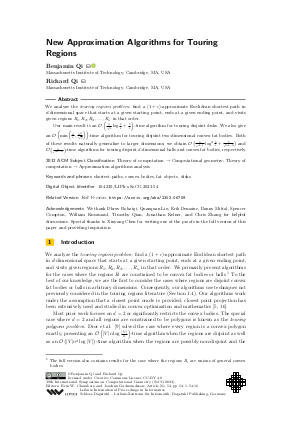New Approximation Algorithms for Touring Regions
Authors
Benjamin Qi  ,
Richard Qi
,
Richard Qi
-
Part of:
Volume:
39th International Symposium on Computational Geometry (SoCG 2023)
Part of: Series: Leibniz International Proceedings in Informatics (LIPIcs)
Part of: Conference: Symposium on Computational Geometry (SoCG) - License:
 Creative Commons Attribution 4.0 International license
Creative Commons Attribution 4.0 International license
- Publication Date: 2023-06-09
File

PDF
LIPIcs.SoCG.2023.54.pdf
- Filesize: 0.81 MB
- 16 pages
Document Identifiers
Related Versions
- Full Version https://arxiv.org/abs/2303.06759
Subject Classification
ACM Subject Classification
- Theory of computation → Computational geometry
- Theory of computation → Approximation algorithms analysis
Keywords
- shortest paths
- convex bodies
- fat objects
- disks
Metrics
- Access Statistics
-
Total Accesses (updated on a weekly basis)
0PDF Downloads0Metadata Views
Abstract
We analyze the touring regions problem: find a (1+ε)-approximate Euclidean shortest path in d-dimensional space that starts at a given starting point, ends at a given ending point, and visits given regions R₁, R₂, R₃, … , R_n in that order.
Our main result is an O (n/√ε log{1/ε} + 1/ε)-time algorithm for touring disjoint disks. We also give an O(min(n/ε, n²/√ε))-time algorithm for touring disjoint two-dimensional convex fat bodies. Both of these results naturally generalize to larger dimensions; we obtain O(n/{ε^{d-1}} log²1/ε + 1/ε^{2d-2}) and O(n/ε^{2d-2})-time algorithms for touring disjoint d-dimensional balls and convex fat bodies, respectively.
Cite As Get BibTex
Benjamin Qi and Richard Qi. New Approximation Algorithms for Touring Regions. In 39th International Symposium on Computational Geometry (SoCG 2023). Leibniz International Proceedings in Informatics (LIPIcs), Volume 258, pp. 54:1-54:16, Schloss Dagstuhl – Leibniz-Zentrum für Informatik (2023)
https://doi.org/10.4230/LIPIcs.SoCG.2023.54
BibTex
@InProceedings{qi_et_al:LIPIcs.SoCG.2023.54,
author = {Qi, Benjamin and Qi, Richard},
title = {{New Approximation Algorithms for Touring Regions}},
booktitle = {39th International Symposium on Computational Geometry (SoCG 2023)},
pages = {54:1--54:16},
series = {Leibniz International Proceedings in Informatics (LIPIcs)},
ISBN = {978-3-95977-273-0},
ISSN = {1868-8969},
year = {2023},
volume = {258},
editor = {Chambers, Erin W. and Gudmundsson, Joachim},
publisher = {Schloss Dagstuhl -- Leibniz-Zentrum f{\"u}r Informatik},
address = {Dagstuhl, Germany},
URL = {https://drops.dagstuhl.de/entities/document/10.4230/LIPIcs.SoCG.2023.54},
URN = {urn:nbn:de:0030-drops-179047},
doi = {10.4230/LIPIcs.SoCG.2023.54},
annote = {Keywords: shortest paths, convex bodies, fat objects, disks}
}
Author Details
Acknowledgements
We thank Dhruv Rohatgi, Quanquan Liu, Erik Demaine, Danny Mittal, Spencer Compton, William Kuszmaul, Timothy Qian, Jonathan Kelner, and Chris Zhang for helpful discussions. Special thanks to Xinyang Chen for writing one of the proofs in the full version of this paper and providing inspiration.
References
- Xxii open cup, grand prix of siberia, 2022. Last accessed 9 April 2022. URL: https://codeforces.com/blog/entry/96710.
-
Alok Aggarwal and Maria Klawe. Applications of generalized matrix searching to geometric algorithms. Discrete Applied Mathematics, 27(1-2):3-23, 1990.

-
Arash Ahadi, Amirhossein Mozafari, and Alireza Zarei. Touring a sequence of disjoint polygons: Complexity and extension. Theoretical Computer Science, 556:45-54, 2014.

-
Tetsuo Asano, David Kirkpatrick, and Chee Yap. Pseudo approximation algorithms with applications to optimal motion planning. Discrete & Computational Geometry, 31(1):139-171, 2004.

- Heinz H. Bauschke and Jonathan M. Borwein. On projection algorithms for solving convex feasibility problems. SIAM Review, 38(3):367-426, 1996. URL: https://doi.org/10.1137/S0036144593251710.
-
Timothy M Chan. (near-) linear-time randomized algorithms for row minima in monge partial matrices and related problems. In Proceedings of the 2021 ACM-SIAM Symposium on Discrete Algorithms (SODA), pages 1465-1482. SIAM, 2021.

-
Chang-Chien Chou. An exact algorithm for computing the shortest path touring n circles in 2d. In International Conference on Computational Problem-Solving, pages 98-103, 2010.

- P. L. Combettes and H. J. Trussell. Method of successive projections for finding a common point of sets in metric spaces, December 1990. URL: https://doi.org/10.1007/bf00939646.
- Moshe Dror, Alon Efrat, Anna Lubiw, and Joseph S. B. Mitchell. Touring a sequence of polygons. In Proceedings of the Thirty-Fifth Annual ACM Symposium on Theory of Computing, STOC '03, pages 473-482, New York, NY, USA, 2003. Association for Computing Machinery. URL: https://doi.org/10.1145/780542.780612.
- Alon Efrat, Günter Rote, and Micha Sharir. On the union of fat wedges and separating a collection of segments by a line. Comput. Geom. Theory Appl., 3(5):277-288, November 1993. URL: https://doi.org/10.1016/0925-7721(93)90018-2.
-
Peter Gritzmann and Victor Klee. Computational convexity. CRC Press, Taylor; Francis Group, a Chapman; Hall Book, 2017.

- Matthew J. Katz. 3-d vertical ray shooting and 2-d point enclosure, range searching, and arc shooting amidst convex fat objects. Computational Geometry, 8(6):299-316, 1997. URL: https://doi.org/10.1016/S0925-7721(96)00027-2.
-
Amirhossein Mozafari and Alireza Zarei. Touring polygons: An approximation algorithm. In IWOCA, 2012.

- Mark H. Overmars. Point location in fat subdivisions. Information Processing Letters, 44(5):261-265, 1992. URL: https://doi.org/10.1016/0020-0190(92)90211-D.
-
Mark H. Overmars and A.F. van der Stappen. Range searching and point location among fat objects. J. Algorithms, 21:629-656, 1996.

- R. R. Phelps. Convex sets and nearest points. Proceedings of the American Mathematical Society, 8(4):790-797, 1957. URL: http://www.jstor.org/stable/2033300.
-
Valentin Polishchuk and Joseph SB Mitchell. Touring convex bodies-a conic programming solution. In CCCG, pages 290-293, 2005.

- David J. Smith and Mavina K. Vamanamurthy. How small is a unit ball? Mathematics Magazine, 62(2):101-107, 1989. URL: http://www.jstor.org/stable/2690391.
-
Xuehou Tan and Bo Jiang. Efficient algorithms for touring a sequence of convex polygons and related problems. In T.V. Gopal, Gerhard Jäger, and Silvia Steila, editors, Theory and Applications of Models of Computation, pages 614-627, Cham, 2017. Springer International Publishing.

